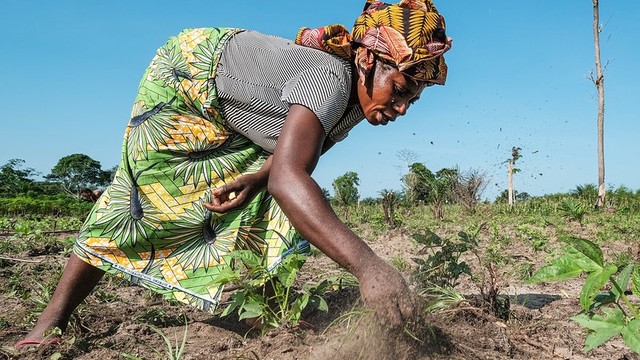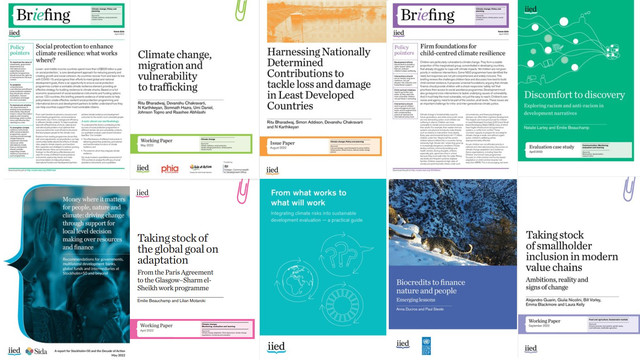IIED's best of 2023: blogs
As 2023 draws to a close, we're showcasing some of the content we've published during the last 12 months. Our blogs offer a place for IIED staff and guest authors to share their personal views and experiences – in case you missed them, here are our top 10 most-read blogs of the year.

A cassawa flour producer from Adjegounle village, Benin (Photo: Arne Hoel/World Bank, via Flickr, CC BY-NC-ND 2.0)
1. Asia’s fastest growing cities… and why these are mostly small cities
When urban specialist David Satterthwaite was handed a list of Asia’s fastest growing cities he didn’t recognise any of them, while the list of those with the largest annual increases in population was very familiar. Why was that?

There is a great enthusiasm for lists of cities and their populations’ rate of change. But ‘league tables’ of cities need to be drilled down to work out what is really going on – and what all this could mean for the future of Asian cities more generally.
2. Lessons from East Africa: getting climate and conservation funding to Indigenous Peoples and local communities
Guest bloggers Fred Nelson and John Kamanga discussed how learning from Maliasili's Maasai Landscape Conservation Fund’s first three years of providing grants to local organisations in Kenya and Tanzania can inform the design of other funding mechanisms to support Indigenous Peoples and other local communities' conservation and natural resource management efforts in Africa and beyond.

The savannah rangelands in southern Kenya and northern Tanzania are one of the world’s most spectacular landscapes for Indigenous cultures, wildlife and nature. And here, a range of grassroots organisations and national civil society alliances – such as the Kenya Wildlife Conservancies Association – play a key role in developing effective approaches to community-led ecosystem management and restoration.
3. A new climate finance goal is in the making: what must happen in 2023?
As technical experts gathered in Vienna to resume talks on a new global goal for post-2025 climate finance back in March, Illari Aragon explored the issues that will be critical at the negotiations.

While it is important to discuss the nature and value of these different instruments – especially as they represent alternatives to loans – it is also crucial to analyse their suitability for the different thematic responses (mitigation, adaptation and loss and damage)
4. The favela of Rocinha: decades of struggle have led to a rich political – and cultural – landscape
A museum in an informal settlement? Guest blogger Thaisa Comelli described in this blog the groundbreaking work of the Sankofa Museum in Rocinha – one of Rio de Janeiro’s largest informal settlements – in one of three examples of the power of its community organisations.

The favela still faces challenges with constant water shortages, flooding and landslides, which lead to contemporary forms of activism that mix old and new agendas.
5. Urbanising the Intergovernmental Panel on Climate Change
Our bloggers David Satterthwaite and David Dodman looked at how – over time – the IPCC has come to recognise the crucial role urban areas play in adaptation to climate change and its mitigation.

A summary for urban policymakers was also prepared for the IPCC’s special report on global warming of 1.5°C. This highlighted the significant and alarming consequences that climate change is expected to have on urban areas.
6. Understanding the gender imbalance at the international climate negotiations
Emerging findings of a new study provided insights into the challenges women face in participating in critical UN international climate talks. Fernanda Alcobé and Elaine Harty explored this in a blog.

But the greatest barrier is that, despite being motivated to participate in the negotiations, women are often overlooked in favour of men when it comes to delegation selection and leadership roles.
7. Addressing power dynamics and inequity in institutional partnership models
IIED is engaging in research and learning about partnership models with the aim of developing a good practice framework for ethical and equitable partnerships. In this blog, Tracy Kajumba highlighted some of the barriers that prevent fair partnerships and set out five steps to overcome them.

There is a trend towards emphasising joint projects between the global North and global South organisations. But Southern partners have little input into proposals; often, they are selected at the last minute by Northern organisations who make all the project decisions.
8. The 30x30 target: more opportunity, less threat than expected?
Amid mixed views of the final form of the 30x30 target agreed at the CBD COP15, Orla Corbisiero and Phil Franks reviewed the reactions of many organisations that support Indigenous Peoples and local communities to consider whether the target presents more of an opportunity and less of a threat to Indigenous Peoples and local communities than they had anticipated prior to COP15.

A key next step for the GBF is the development of the robust monitoring framework for COP16 in two years’ time. The indicators must provide practical measures of respect for rights, (including human rights), participation, access to information and justice, and financing that can help ensure that the 30x30 target is indeed a real opportunity to advance IPLC-led conservation.
9. Reform the global financial system to support transformational adaptation
Following discussions at the Bonn Climate Change Conference and Paris Summit for a New Global Financial Pact, UnaMay Gordon reflected on whether efforts to reform the world’s financial and economic systems go far enough to address the causes of unsustainable debt burdens of low-income countries

We need an international financing system that does not perpetuate and exacerbate spirals of debt and inequality.
10. Ecosystem-based adaptation: three ways evidence can influence policymakers
Ecosystem-based adaptation (EbA) involves people working with nature to adapt to the adverse effects of climate change. Evidence from locally led EbA is essential for designing successful international and national climate, nature and economic policies. Communications specialist and IIED senior associate Gabriela Flores Zavala wrote about this.

Championing EbA initiatives that work and getting these recognised in policy will bring benefits to climate, nature and people. EbA practitioners can prove – and many already are – that locally led initiatives harness biodiversity and ecosystem services to support climate adaptation, and do so in ways that are also cost-effective. The question remains: are policymakers ready to listen?
Bonus: Climate action is being held back by ‘hidden handbrakes’
Despite global efforts to tackle the devastating effects of climate change, we are falling short of meeting the world's climate goals. What is hindering our progress? This blog by Tom Mitchell exposed some hidden handbrakes.

Greater public awareness of all the factors holding us back from rapid action should allow more people to decide whether these ‘handbrakes’ should continue, and whether they are compatible with the kind of world we want to live in.
That's our top 10 – but there were many more! To see all our 2023 opinion pieces, visit our blogs page where we give our experts and partners the platform to provide insight into key events, updates on ongoing research, and share experiences from their work.



